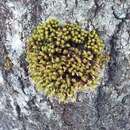en
names in breadcrumbs


Das Gewöhnliche Krausblattmoos (Ulota crispa) ist eine Laubmoos-Art aus der Familie Orthotrichaceae.
Das Gewöhnliche Krausblattmoos ist in den Merkmalen und Standortansprüchen der Schwesterart Bruchs Krausblattmoos sehr ähnlich. Es bildet bis 2 Zentimeter große, runde, gelbgrüne Polster. Die aus eiförmiger Basis lineal-lanzettlichen, allmählich zugespitzten, etwa 3 Millimeter langen Blätter sind trocken stark gekräuselt, feucht mehr oder weniger abstehend. An den Rändern der Blattbasis befinden sich jeweils mehrere Reihen aus rechteckigen, wasserhellen Zellen. Die Laminazellen im oberen Blattteil sind papillös, rundlich-oval und meist 9 bis 12 µm groß (etwas kleiner als bei Bruchs Krausblattmoos). Sporophyten sind etwa 3 bis 5,5 Millimeter lang (ohne Deckel), die Kapsel jung und feucht glatt und oval, später tief längsgefurcht, schlank, weitmündig und unterhalb der Mündung verengt. Das Peristom ist doppelt, die äußeren Peristomzähne sind trocken zurückgeschlagen. Das Moos ist einhäusig und fruchtet regelmäßig. Sporenreifezeit ist im Frühling und Sommer.
Als Epiphyt wächst das Gewöhnliche Krausblattmoos bevorzugt auf Borke von Laubbäumen, seltener von Nadelbäumen, gerne in luftfeuchten Wäldern wie in Bachtälern, Quellgebieten oder Mooren, aber auch in lichtreichen Waldrandlagen. Häufige Begleitmoose sind Orthotrichum-Arten, Ulota bruchii, Frullania dilatata, Radula complanata oder Hypnum cupressiforme. Auf Luftverschmutzung reagiert diese früher allgemein verbreitete Art empfindlich und wurde dadurch gebietsweise stark dezimiert.
Diese Moosart ist in der nördlichen Hemisphäre verbreitet. Neben Europa kommt es vor in Teilen Asiens, auf den Atlantischen Inseln, in Nordamerika, in Nordafrika. Ein weiteres Vorkommen gibt es in Tasmanien.
Das Gewöhnliche Krausblattmoos wurde außer dem gültigen wissenschaftlichen Namen Ulota crispa (Hedw.) Brid. unter folgenden Synonymen beschrieben:
Das Gewöhnliche Krausblattmoos (Ulota crispa) ist eine Laubmoos-Art aus der Familie Orthotrichaceae.
Ulota crispa, the crisped pincushion moss,[1] is a species of acrocarpous moss in the genus Ulota native to eastern North America. It is generally found in tight mounds on tree bark.[2][3][4]
Ulota crispa, the crisped pincushion moss, is a species of acrocarpous moss in the genus Ulota native to eastern North America. It is generally found in tight mounds on tree bark.
Nastroszek kędzierzawy (Ulota crispa (Hedw.) Brid.) – gatunek mchu należący do rodziny szurpkowatych (Orthotrichaceae). Rośnie na gałęziach i pniach drzew, szczególnie brzóz[3].
Gatunek występuje w Europie, Azji i Ameryce Północnej, gdzie jego zasięg rozciąga się od Nowej Fundlandii na zachód do Minnesoty i na południe przez Appalachy do północnej Georgii[3].
Roślina objęta jest w Polsce częściową ochroną gatunkową na podstawie Rozporządzenia Ministra Środowiska z dnia 9 października 2014 w sprawie ochrony gatunkowej roślin[4]. W latach 2004–2014 podlegała ochronie ścisłej[5].
Nastroszek kędzierzawy (Ulota crispa (Hedw.) Brid.) – gatunek mchu należący do rodziny szurpkowatych (Orthotrichaceae). Rośnie na gałęziach i pniach drzew, szczególnie brzóz.
Ulota crispa là một loài Rêu trong họ Orthotrichaceae. Loài này được (Hedw.) Brid. miêu tả khoa học đầu tiên năm 1819.[1]
Ulota crispa là một loài Rêu trong họ Orthotrichaceae. Loài này được (Hedw.) Brid. miêu tả khoa học đầu tiên năm 1819.
北方捲葉蘚(学名:Ulota crispa)为木靈蘚科捲葉蘚屬下的一个种。
|access-date=中的日期值 (帮助)